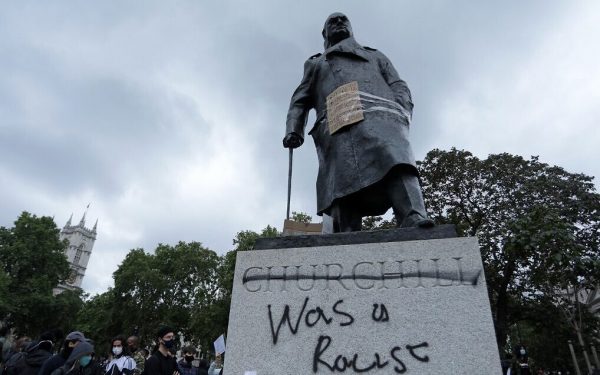We can’t speak rightly of justice if we’re too crazy and exhausted to think straight.
Race Fantasies

Even the hardest-nosed conservatives have been suckered by a vision of American racial harmony.
A new version of American twenty-first century history has taken hold on the Right. According to this narrative, American race relations were improving through the Bush years, only to be roiled by the election (and especially the re-election) of Barack Obama. Democrats revived dying racial animosity to divide the electorate with the result that the country is now disastrously polarized. The new racial activists have, allegedly, betrayed the authentic colorblind vision of the civil rights movement of the sixties, as embodied by Martin Luther King, Jr.
For example, after a generally accurate description of how our “culture is in collapse,” Victor Davis Hanson offered this lament for the vanishing recent past: “Why, when so-called non-white ethnicities and races were achieving parity with or exceeding the majority population in per capita income and when racial intermarriage was commonplace did we blow up the values of the civil rights movement and revert to precivilizational tribalism?” I find this statement, to say the least, problematic. Clearly Hanson and I see the path by which we reached our collapsing culture and corrupted polity quite differently. Unlike him, I do not recall a recent golden age of racial harmony brought about by his ideal civil rights movement (assuming, perhaps counterfactually, that there was only one such movement, and it reflected VDH’s ideals).
Racial turmoil has roiled this country for decades; and most of the social problems that fueled them have stayed around and grown worse. A multitude of civil rights laws and directives have been enacted at the federal, state, and local levels to empower leftist activists, throw tax money at disintegrating, crime-ridden black communities, and more recently, raise the self-esteem of black racial activists at the expense of whites and Asians.
None of these measures, however, has improved the social condition of most American blacks or lessened their animosity toward the white majority. To believe this situation was significantly different 20 or 30 years ago because of “the values of the civil rights movement” is to overlook the longevity of problems that the civil rights revolution did little to change. Affirmative action programs go back to the sixties and started soon after the passage of the 1964 Civil Rights Act. After the passage of that landmark legislation, government officials made clumsy attempts to guarantee that business and social transactions were free of anti-black and anti-feminine bias. The result was set asides for blacks and women, a category of humanity who also became a protected group under the 1964 act. Black nationalist manifestations of the crusade against discrimination, moreover, were abundantly evident in the sixties, which saw the rise of the black power movement. Although this movement did not poison our national politics immediately, black racism eventually became integral to the Democratic Party’s national coalition.
The reason for these intractable race tensions has been the failure to address a social pathology that has accompanied the civil rights revolution, the disintegration of a responsible, self-sustaining black community. Thomas Sowell properly noted that blacks made far greater socio-economic strides from 1940 to 1960 than during the subsequent civil rights era, which saw massive social breakdown. Blacks who moved into Southern and then Northern cities encountered serious difficulties in their new surroundings. In these cities there was a diminishing number of jobs for unskilled labor but a never-ending supply of drugs together with other temptations of modern urban life. Never-ending protests against white racism and the favoring of black politicians who specialized in race hustling, without fixing social problems, became the long-range response of those living in these shattered, crime-ridden communities.
Sowell called further attention to facts that were already obvious to Daniel P. Moynihan, Edward Banfield, and other eminent sociologists during the civil rights era. Giving in to angry people blaming their social problems on “whitey” or “the Man” has not created a more harmonious society. Among the most noticeable long-run beneficiaries of the civil rights revolution have been race-hustlers like Maxine Waters, Nancy Pelosi, Jamaal Bowman, and Reverend Al, the academic directors of “white privilege” studies, and the recipients of DEI funds provided by virtue-signaling corporate capitalists.
Transgendered activists have also been the beneficiaries of a movement that has been driven forward by the administrative state, and which has enjoyed the support of culturally radicalized media, woke capitalists, and bourgeois-hating educators. That this movement has embraced ever more imaginative categories of designated victims seems in retrospect to be fully understandable. We are looking at an incremental revolution that has gone on for decades.
One may be allowed to offer this generalization without condoning the justified grievances of blacks who lived under Jim Crow. Like our civil rights movement, revolutionaries usually start with just causes, but this doesn’t mean we should applaud the results of their activities. In eighteenth-century France, peasants endured the imposition of servile labor while the French professional classes suffered annoying social restrictions. But recognizing that situation does not require me to approve of the bloodbath caused by the French Revolution.
It is reasonable to notice that what starts out as a just protest can turn very bad; and it is equally reasonable to assume a possible connection between the beginning and end of this development. Burke was among those who grasped this notion of a derailed protest in his Reflections, a work that contains both a famous diatribe against the French Revolution and proposals for what the ancien régime could have done to address social grievances in a timely fashion. Criticizing ominous upheavals does not signify acceptance of the situation that revolutionaries claim to be rectifying. But a proper general assessment does demand that I notice the deep-seated nature of a disaster that continues to engulf us.
Hanson also assures us that racial intermarriage was “commonplace” in that happy age to which he now looks back nostalgically. That practice has become even more “commonplace” in the last few decades. According to a Pew study, racial intermarriage took place in the U.S. in only three percent of marital unions in 1967; by 2015 that number had risen to 17 percent. Although intermarriage between whites and Asians is now more common than between whites and blacks, 24 percent of black males are married to women of a different race. But there’s no reason to believe that this increasing rate of intermarriage has lessened racial tensions in this country, which seem to be higher than they were in the middle of the twentieth century.
What often happens is that those whites who intermarry with other ethnic or racial groups bear the hostilities of those they intermarry with. German Christian women who marry Muslims (and in many cases convert) are usually looking for an identity to take the place of a German one they’ve rejected. These Islamophilic German women are not blending loyalties and identities by taking racially or ethnically different marital partners. They are looking to identify with the ethnicity and ethnic grievances of the persons they are marrying. Although intermarriage may indicate the union or reconciliation of groups, there is no reason to believe this is always the intended outcome.
It should be obvious that Hanson and I have different understandings of the social and political crisis that both of us are trying to understand. He seems to believe the U.S. was becoming a racially harmonious democracy while showering its human rights on the world, until we suddenly fell off a cliff. A usually sound interpreter of current events, he is palpably shocked by what happened to his lost dream. Although I share his concern about present realities, I certainly don’t feel his bewilderment.
The American Mind presents a range of perspectives. Views are writers’ own and do not necessarily represent those of The Claremont Institute.
The American Mind is a publication of the Claremont Institute, a non-profit 501(c)(3) organization, dedicated to restoring the principles of the American Founding to their rightful, preeminent authority in our national life. Interested in supporting our work? Gifts to the Claremont Institute are tax-deductible.
Liberal bromides are pushed aside for traditional roles.
The regime is desperate to impose polyamory.
Reject the fiction of perfection for the messiness of the world outside your head.
Democrats are increasingly beholden to leftist radicals in their midst.
Among the silent majority.






